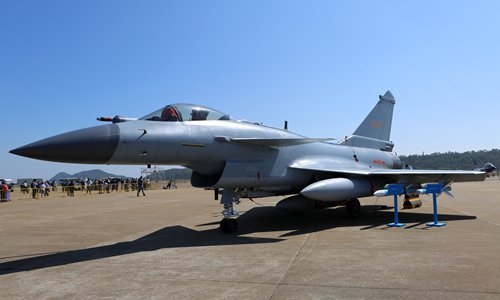
A J-10B fighter jet at the opening ceremony of Airshow China 2018 in Zhuhai, South China's Guangdong Province, on November 6, 2018. (Photo: VCG)
Spectators in the entire audience were stunned and let out a deep and collective wow when a J-10B fighter jet danced in the sky at the opening ceremony of Airshow China 2018 in Zhuhai, South China's Guangdong Province on November 6.
Before the event, it was hard to believe that the J-10B, a type of military aircraft already in service in the People's Liberation Army (PLA) for years, could amaze so many people.
However, this specific one was different: it made a series of aerobatic maneuvers that no one expected it to be able to do.
The audience could not help but gave a cry of surprise when the fighter jet almost hovered in the air and made a 180-degree turn without moving horizontally.
"Tell me this is real," a spectator, who stood near the Global Times reporter, said to himself.
This is very much real. And it was not only the impressive maneuvers that amazed Chinese military observers, but more importantly, the technology behind it.
Leap in engine tech
This J-10B is equipped with an engine capable of thrust vectoring control, which means that the engine can change the direction of its thrust, thus realizing extreme maneuverability that can give the aircraft significant advantages in dogfights, Chinese military experts said.
The J-10B is the world's first single-engine canard wing fighter jet to perform such maneuvers, the announcer at the air show said.
The manufacturer of the J-10B, Aviation Industry Corporation of China, said in a statement that the thrust vectoring control technology used on the aircraft was an independently developed innovation, making China one of a few countries in the world to master this key technology.
The engine for aircraft was widely regarded as a weakness in China's military development, and it was almost every Chinese military observer's dream to see the country's independently developed engines become world-class.
"China used to trail far behind countries like the US and Russia in terms of aeronautical engines. But now we can build our own thrust vectoring engines," a visitor who did not give his name told the Global Times.
"The J-10B's performance gave me a great confidence boost," he said. "I understand that China is still not among the best in aeronautical engines, but I am now convinced we can achieve that position sooner than I had expected," he said.
A Chinese military expert, who asked not to be named, told the Global Times that China is catching up in the thrust vectoring control aspect of the engine, and the State-owned Aero Engine Corporation of China is continuing to work in order for the engines to provide more thrust and prolong the life span.
Despite impressive displays at the air show, China is still 20 to 30 years behind the US in the overall design of the engines, the expert said.
"It is worth celebrating today for what we have achieved, but it is not yet the time to become overconfident and think there is nothing left to do," he said.
Setting the standards
Just as people savored the aftertaste of the performance of the thrust vectoring J-10B and seemed to forget about the fact that the J-20 is China's most advanced fighter jet, the stealth aircraft made a surprising display on the last day of the air show.
For the first time in public, it exhibited its missiles in its belly mid-flight.
Capable of carrying four long-range air-to-air missiles and two short-range combat missiles hidden in missile bays, the J-20 possesses strong aerial control capability while maintaining low visibility on radar, experts said.
Witnessing a formation of four J-20s howling through the sky, a boy aged about five told his parents that he would like to become a fighter jet pilot in the future.
Military experts said that the J-20 show displays the openness and confidence of the PLA to foreign countries.
The J-20's chief designer Yang Wei said in a China Central Television program that the thrust vectoring control engine used on the J-10B can be installed on any fighter jets any time if needed, including the J-20".
The generation standards for fighter jets were defined by Western countries in the past, but they have not defined future standards, Yang said, noting that China will design very different aircraft in the future through true innovation.


